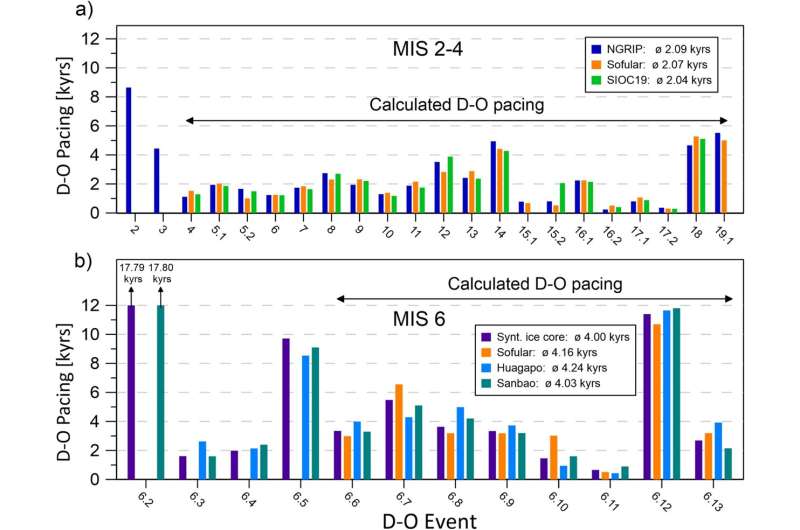This article has been reviewed according to Science X's editorial process and policies. Editors have highlighted the following attributes while ensuring the content's credibility:
fact-checked
peer-reviewed publication
trusted source
proofread
Using isotopic measurements on stalagmites to investigate 'climate hiccups'

Climate changes usually happen over long periods of time, but during the last glacial period, extreme fluctuations in temperature occurred within just a few years. Researchers at the University of Basel have now been able to prove the phenomenon also occurred during the penultimate glacial period.
In recent geological history, the so-called Quaternary period, there have been repeated ice ages and warm periods. Researchers are able to determine past climate variability from the composition of climate records. In the case of the last glacial period 100,000 years ago, ice cores from Greenland in particular provide researchers with detailed data.
For example, Greenland ice cores show that there were repeated rapid increases in temperature. "We are talking about increases of 5 to 10 degrees within 30 to 40 years on average in the case of Europe. A Neanderthal would have experienced increases in the average temperature of several degrees over the course of their life," explains Prof. Dominik Fleitmann, Professor of Quaternary Geology at the University of Basel. He calls the phenomena "climate hiccups."
These Dansgaard-Oeschger events are well documented for the last glacial period, but the climate records from Greenland only cover the last 120,000 years. It was therefore previously unknown whether these Dansgaard-Oeschger events also occurred during the penultimate glacial period 135,000 to 190,000 years ago.
Frederick Held, a Ph.D. candidate in Fleitmann's research group, was able to show that Dansgaard-Oeschger events also occurred during the penultimate glacial period using isotopic measurements on stalagmites. He is the lead author of the study, which was published in the scientific journal Nature Communications.
The North Atlantic as the source of change
The stalagmites examined originate from the Sofular Cave in Turkey, which is located in a region that is very sensitive to climate change. The researchers therefore refer to it as a key region, as it is influenced by the winds of the North Atlantic, and the Black Sea is just a few kilometers away. "We used the isotopic composition in the stalagmites to determine the moisture sources from which they are formed—the Black Sea, the Mediterranean Sea and the North Atlantic," explains Frederick Held.
For the first time, the evaluations carried out on the stalagmites from the Sofular Cave have proven that Dansgaard-Oeschger events also occurred during the penultimate glacial period. "It was previously unknown whether these relatively brief temperature events actually happened in earlier glacial periods," states Held. However, they occurred less frequently in the penultimate glacial period than in the last one. "The temperature peaks are twice as far apart from one another, meaning there were longer cold phases between them," says Held.
These temperature fluctuations originate in the North Atlantic, as the circulation of the ocean is a global conveyor belt for heat and can sometimes be stronger and sometimes weaker. "For example, the circulation affects the exchange of heat between the atmosphere and the ocean, which, in turn, impacts the balance of heat in the Northern Hemisphere and air flows and rainfall," explains Held. He states that weakened circulation also reduces the quantity of CO2 that the ocean absorbs from the atmosphere.
These ocean currents were different in the penultimate glacial period than in the last one, which explains the different intervals between the Dansgaard-Oeschger events. This shows that not all glacial periods are the same and not all warm periods are the same.
The researchers compared the data from the stalagmites with marine sediment cores, which also act as a natural climate archive. The more pieces there are in the puzzle, the more accurate the picture of what happened, and feedback mechanisms can be captured more precisely.
Better understanding the mechanisms
Taking a look at the last two glacial periods, it becomes clear how fast climate can change. "Climate change drives forward new ecosystems," says Dominik Fleitmann. "Our dream is to create a continuous dataset for the last 600,000 to 700,000 years and close any gaps in our knowledge."
The evaluations help us to better understand the Earth in terms of which factors result in abrupt fluctuations in climate, what trends can be observed and how and under what conditions the oceans' circulation patterns change.
Current climate models can be tested using data from the past. "Patterns that are established can help climate researchers to further improve their models and therefore refine assumptions for future trends," explains Fleitmann.
The geologist also hopes to clarify any outstanding questions by means of additional analyses. "For example, we do not yet know whether the increases in temperature were periodic or stochastic, in other words random." Ph.D. candidate Frederick Held adds, "Until now, we have been able to describe the trends, but it would be great if we were able to establish an absolute temperature value."
More information: F. Held et al, Dansgaard-Oeschger cycles of the penultimate and last glacial period recorded in stalagmites from Türkiye, Nature Communications (2024). DOI: 10.1038/s41467-024-45507-5
Journal information: Nature Communications
Provided by University of Basel



















